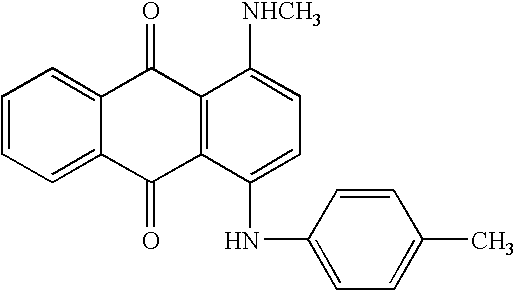Cellulose ester film, optically compensatory film, polarizing plate, and liquid crystal display device
a liquid crystal display device and cellulose ester technology, applied in the direction of polarizing elements, camera filters, instruments, etc., can solve the problems of low compatibility between cellulose ester and polyester polyol, difficult to apply to va mode liquid crystal display devices which require high optical anisotropy, and difficult to be used practically. , to achieve the effect of hardly generating bleed-out, low surface state failure, and high production efficiency
- Summary
- Abstract
- Description
- Claims
- Application Information
AI Technical Summary
Benefits of technology
Problems solved by technology
Method used
Image
Examples
examples
[0223]Hereinafter, the present invention is specifically described with reference to the following Examples, but it should not be construed that the present invention is limited thereto.
[0224]Polycondensates P-1 to P-19, P-43, and P-44 and Comparative polycondensates 1 to 14, which were used in Examples and Comparative Examples, are shown in Table 2 and Table 3.
TABLE 2Dicarboxylic acid residue *1)AverageRatio ofcarbonAverageRatio ofaromaticnumber ofcarbonAromaticAliphaticdicarboxylicdicarboxylicaliphaticRatio ofnumber ofNumberdicarboxylicdicarboxylicacidaciddicarboxylicdiolaliphaticaverageacidacidresiduesresiduesacidAliphaticresiduesdiolmolecularresidueresidue(mol %)(mol %)residuediol residue(mol %)residuesBoth terminalsweightP-1TPA / PASA / AA45 / 5 / 30 / 20504.8Ethylene glycol1002.0Acetyl ester700residueP-2TPA / PASA / AA45 / 5 / 30 / 20504.8Ethylene glycol1002.0Acetyl ester900residueP-3TPA / PASA / AA45 / 5 / 30 / 20504.8Ethylene glycol1002.0Acetyl ester1000residueP-4TPA / PASA / AA45 / 5 / 30 / 20504.8Ethylene glycol...
example 226
Preparation of Polarizing Plate and Mounting Experiment on Liquid Crystal Displace Device of VA Mode
(Preparation of Polarizing Plate)
[0281]The cellulose acylate film of Example 26 and a commercially available cellulose triacetate film (FUJI TAC TD80UF, manufactured by Fujifilm Corporation) were subjected to the same saponification treatment as described above. Furthermore, the polarizer above was sandwiched by two films using a polyvinyl alcohol-based adhesive, and dried at 70° C. for 10 minutes or longer to prepare a polarizing plate 226.
[0282]A transmission axis of the polarizer and a slow axis of the cellulose acylate film of
[0283]Example 26 were disposed parallel to each other. The transmission axis of the polarizer and a slow axis of the commercially available cellulose triacetate film were disposed orthogonal to each other.
(Preparation of Liquid Crystal Cell)
[0284]A liquid crystal cell was prepared by regulating a cell gap between substrates at 3.6 μm and pouring dropwise a li...
example 307
Preparation of Polarizing Plate and Mounting Experiment on Liquid Crystal Displace Device of VA Mode
(Preparation of Polarizing Plate)
[0290]The cellulose acylate film of Example 107 and a commercially available cellulose triacetate film (FUJI TAC TD80UF, manufactured by Fujifilm Corporation) were subjected to the same saponification treatment as described above. Furthermore, the polarizer above was sandwiched by two films using a polyvinyl alcohol-based adhesive, and dried at 70° C. for 10 minutes or longer to prepare a polarizing plate 307.
[0291]A transmission axis of the polarizer and a slow axis of the cellulose acylate film of Example 107 were disposed parallel to each other. The transmission axis of the polarizer and a slow axis of the commercially available cellulose triacetate film were disposed orthogonal to each other.
(Preparation of Liquid Crystal Cell)
[0292]A liquid crystal cell was prepared by regulating a cell gap between substrates at 3.6 μm and pouring dropwise a liqui...
PUM
| Property | Measurement | Unit |
|---|---|---|
| thickness | aaaaa | aaaaa |
| thickness | aaaaa | aaaaa |
| transparent | aaaaa | aaaaa |
Abstract
Description
Claims
Application Information
 Login to View More
Login to View More - R&D
- Intellectual Property
- Life Sciences
- Materials
- Tech Scout
- Unparalleled Data Quality
- Higher Quality Content
- 60% Fewer Hallucinations
Browse by: Latest US Patents, China's latest patents, Technical Efficacy Thesaurus, Application Domain, Technology Topic, Popular Technical Reports.
© 2025 PatSnap. All rights reserved.Legal|Privacy policy|Modern Slavery Act Transparency Statement|Sitemap|About US| Contact US: help@patsnap.com



